
Even though there are plenty of detachable options in the consumer market, choices are relatively sparse for enterprise customers. To address the needs of its business users, Lenovo introduced the first generation ThinkPad X1 Tablet in 2016 with its own unique twist—like add-on modules for expansion—to the familiar form factor that was popularized by Microsoft with the Surface Pro series. This year, the ThinkPad X1 Tablet is back with upgraded internals, supporting Intel’s latest 7th Generation Kaby Lake processor architecture, and an iterative design that brings subtle refinements.
And although Lenovo didn’t introduce any new modules this year, the 2017 X1 Tablet is backward compatible with existing add-on peripherals that launched alongside last year’s model, giving this year’s detachable similar expandability that will make it appealing to road warriors.
Design
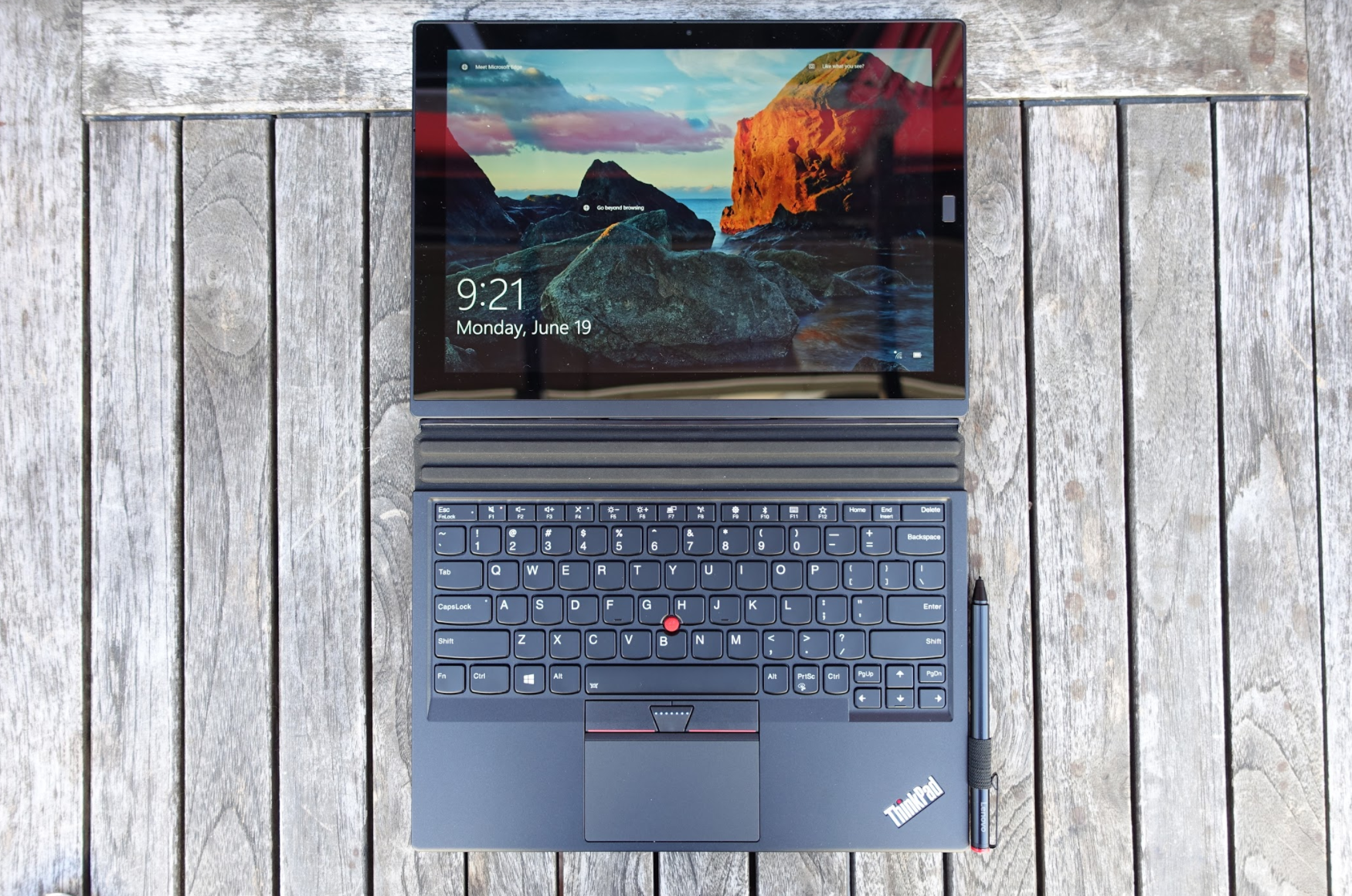
Covered in a unibody magnesium metal enclosure and cloaked in a stark matte black finish, the ThinkPad X1 brings with it the familiar understated business aesthetics that dominates Lenovo’s ThinkPad line. The choice of magnesium makes the ThinkPad X1 Tablet more resistant to dings than the unibody aluminum enclosure on my Apple MacBook Pro. And unlike consumer systems, like the MacBook Pro and the Surface Pro, the ThinkPad X1 Tablet comes with MIL-STD 810G certification, making it more rugged for use in more challenging environments.
With flat, angled edges, and a 0.3-inch thick profile, the ThinkPad X1 Tablet looks more like Microsoft’s Surface Pro 4 rather than the more bulbous edges on this year’s Surface Pro. The 12-inch slab measures 11.4 × 8.2 inches. As a business system, the ThinkPad X1 supports a variety of ports, so you won’t have to carry dongles for basic computing needs. The volume buttons, 3.5mm audio jack and a Kensington lock port are located on the left edge in landscape orientation.
Like last year’s model, the power button sits on the left corner of the top edge, but the button now sits flush with the edge of the tablet. The design improvement makes it harder to accidentally power on the tablet when it’s sitting in a bag. On the right edge, you’ll find a Mini DisplayPort, USB Type-A port and a USB Type-C port that also supports charging.
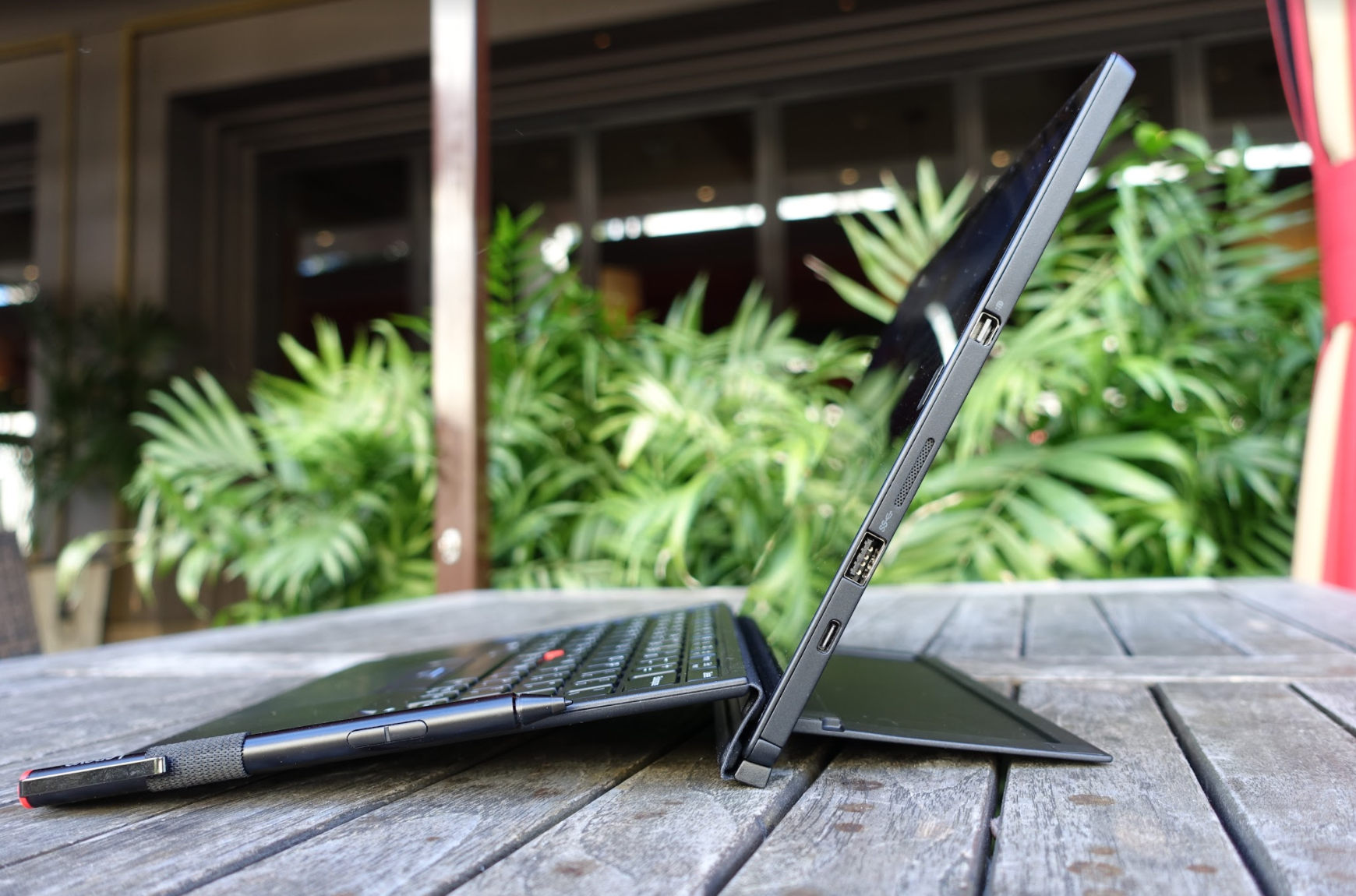
Unfortunately, Lenovo didn’t add support for the faster Thunderbolt 3 over USB Type-C specs on the ThinkPad X1 Tablet, a feature that is standard on the consumer Lenovo Miix 720 that we previously reviewed. Thunderbolt 3 supports faster data transfer speeds, and its inclusion would allow business users to add a graphics dock when using the ThinkPad X1 Tablet at their desk, effectively converting the tablet into a business workstation. Given that Thunderbolt 3 operates over the same USB Type-C port, The lack of Thunderbolt 3 support will likely introduce some compatibility confusion when ThinkPad X1 Tablet owners choose accessories, like docks, in the future. It will also makes the tablet less futureproof once the standard really takes off.
Compared to the Surface Pro and its many competitors, the biggest difference with the ThinkPad X1 is its kickstand. Whereas the Surface Pro’s kickstand folds out from the center of the rear of the tablet, the ThinkPad X1 Tablet’s stand opens out from the bottom edge of the slate, similar to Lenovo’s implementation on its consumer Yoga Tab series. The advantage of Lenovo’s design is that the stand occupies less space when extended, which helps with lapability. The ThinkPad X1 Tablet feels more stable when used on the lap in laptop mode given its bottom-opening kickstand, but there are also disadvantages introduced with this design.
While laptop users will appreciate the lapability advantage, the kickstand’s position isn’t as stable when the tablet is used for writing or drawing on the screen, and graphic artists will prefer the center kickstand placement on the Surface Pro, Lenovo Miix 720 and HP’s Spectre x2 over the ThinkPad X1 Tablet’s design. If you’re looking at a detachable primarily for typing and prefer to write or take notes with the tablet laying flat on a desktop, similar to a pad and pencil experience in the classroom or boardroom, then the X1 Tablet will serve your needs just fine.
Behind the kickstand, there is a microSD card slot. On models with optional 4G LTE connectivity—our review unit did not come with WWAN support—but there is a nano SIM card slot on the tablet.
Display
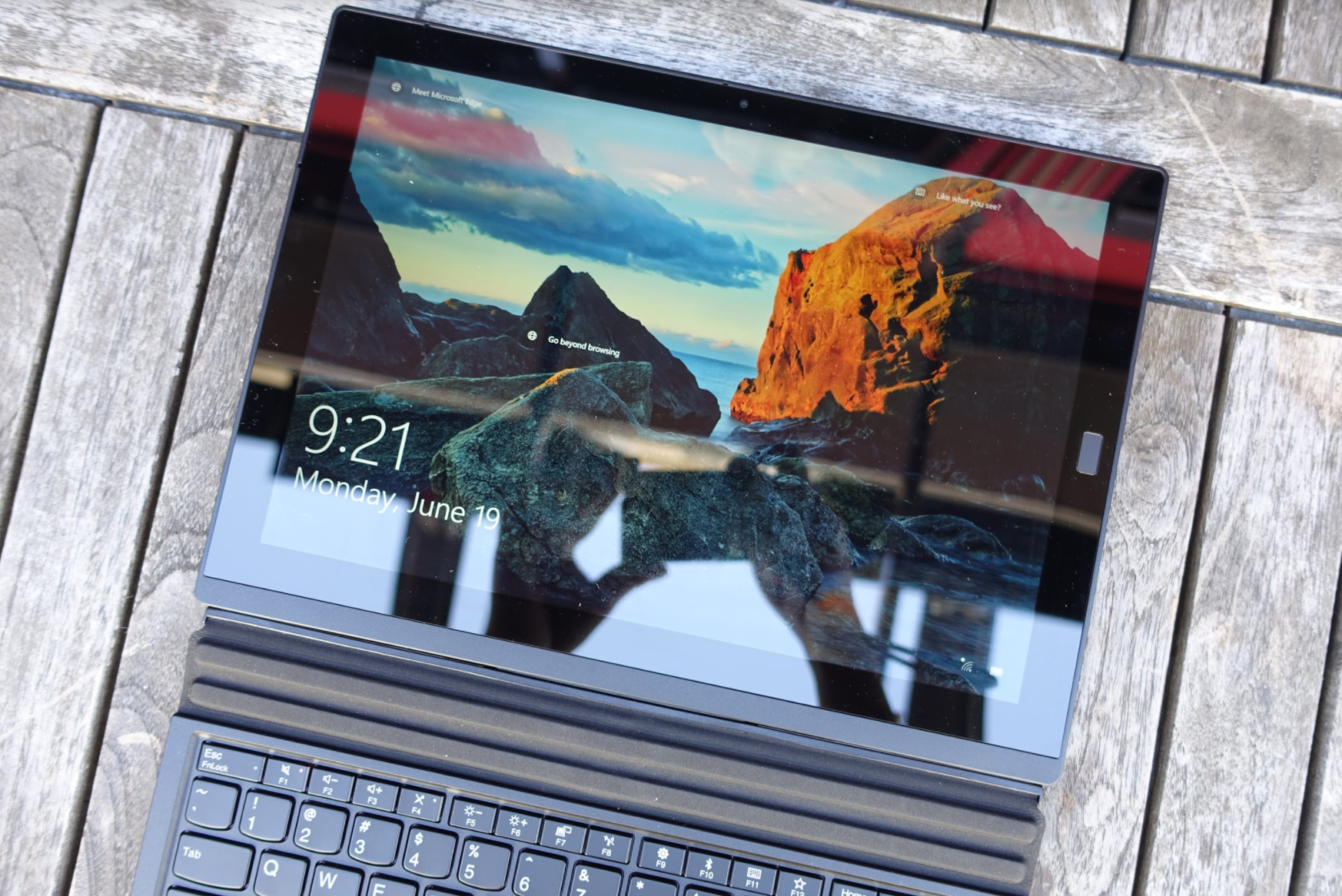
The ThinkPad X1 Tablet comes with a high resolution panel that is vibrant and bright. Colors popped on the 12-inch 2,160 × 1,440-pixel display. Text looks sharp, and videos and photos are sharp with good viewing angles on the IPS panel. The display maintains the same 3:2 aspect ratio as the 2017 Surface Pro, but doesn’t match Microsoft’s 2,736 × 1,824-pixel resolution and falls behind HP’s Spectre x2’s high 3,000 × 2,000-pixel sharpness.
The ThinkPad X1 Tablet’s display gets a lot brighter than the consumer-centric Lenovo Miix 720. This makes the ThinkPad X1 Tablet’s screen more comfortable to read outdoors, and I had no problems viewing the screen under shaded conditions on a bright sunny day. The glossy display appears reflective, exhibiting glare, at lower brightness settings, but cranking up the brightness to 40 percent or higher alleviated these issues.
As a tablet, the ThinkPad X1 supports ten-finger touch input. It also works with Lenovo’s Active Pen, which is based on Wacom’s active stylus technology. And unlike the Surface Pro, the pen is fortunately included in the box.
Keyboard and Touchpad
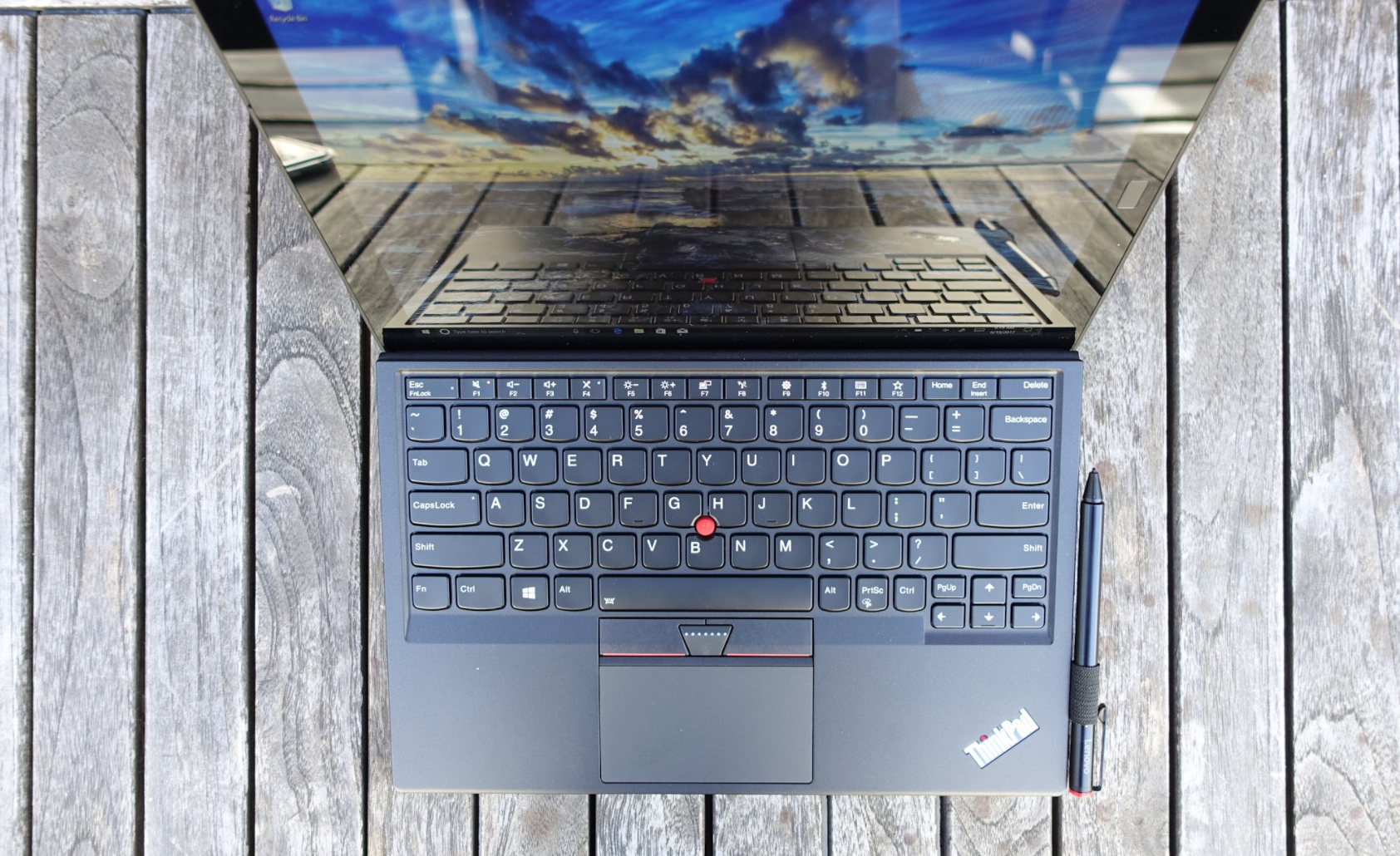
As a detachable, the ThinkPad X1 has a removable keyboard folio. When stowed, the keyboard serves as a cover to protect the tablet’s display. A subtle improvement Lenovo made this year is that a set of magnets help keep the keyboard closed when it’s not in used, a simple feature that’s missing from many competitors’ implementation. In addition to serving to help keep the cover closed, the magnets also quickly put the tablet to sleep when the keyboard is closed over the display.
Like the Surface Pro, the keyboard attaches to the bottom of the tablet with magnets, and a second set of magnets on the bottom of the display can also be used to raise the keyboard to a more comfortable typing position. The keyboard on the ThinkPad X1 Tablet is one of the most comfortable keyboards on a detachable, thanks to Lenovo’s heritage with business ThinkPad keyboard designs. The keyboard comes with three adjustable levels of backlighting brightness, an island-styled arrangement with Lenovo’s smile-shaped key design and curved key caps.
The keyboard comes with 1.2mm of key travel, matching the keyboards offered by HP and Microsoft on the Spectre x2 and Surface Pro Type Cover, and requires 72 grams of actuation force. I appreciated the spacing around the arrow keys, making it easier to hit the proper key without having to look at the keyboard.
The keyboard is very responsive and nicely dampened to not sound overly loud or “clicky,” making it a more discrete typing experience when used during meetings. Coming from consumer Windows keyboard arrangements, it took me some time to adjust to Lenovo’s placement of the Function and Control keys on the ThinkPad X1. If you’re moving from one of Lenovo’s traditional ThinkPad notebooks, you’ll also find the familiar red trackpoint nub along with the three trackpoint keys just above the touchpad.
The touchpad isn’t quite as wide as the one on the Microsoft Surface Pro Type Cover this year, but like Microsoft’s tablet, Lenovo made the switch to Microsoft Precision Touchpad drivers this year. Compared with modern Synaptics drivers, I found sensitivity and performance to be on par, but the switch to Precision drivers will mean faster upgrades and easier touchpad configurations for use with multi-touch gestures. These settings can be changed within Windows 10’s settings panel, rather than having to download separate drivers or use third-party tools.
The keyboard cover is coated with a soft-touch material on the rear and on the keyboard deck. The soft touch coat feels good when you’re resting your palms on the keyboard deck, and unlike older soft touch coatings, doesn’t show as much oils or dirt.
A complaint I had with the 2016 ThinkPad X1 Tablet is that the plastic prongs that help align the keyboard to the POGO pins when it snaps into place with the tablet broke off during the first week of use after removing and reattaching the cover a few times. This was a common complaint with 2016 X1 Tablet owners, and although this flaw didn’t affect the performance of the first generation X1 Tablet, it was a disheartening oversight in design. Fortunately, Lenovo addressed the keyboard design on the second generation cover—the plastic prongs are still present and have not snapped off during my weeks-long testing of the 2nd generation slate.
Windows Hello
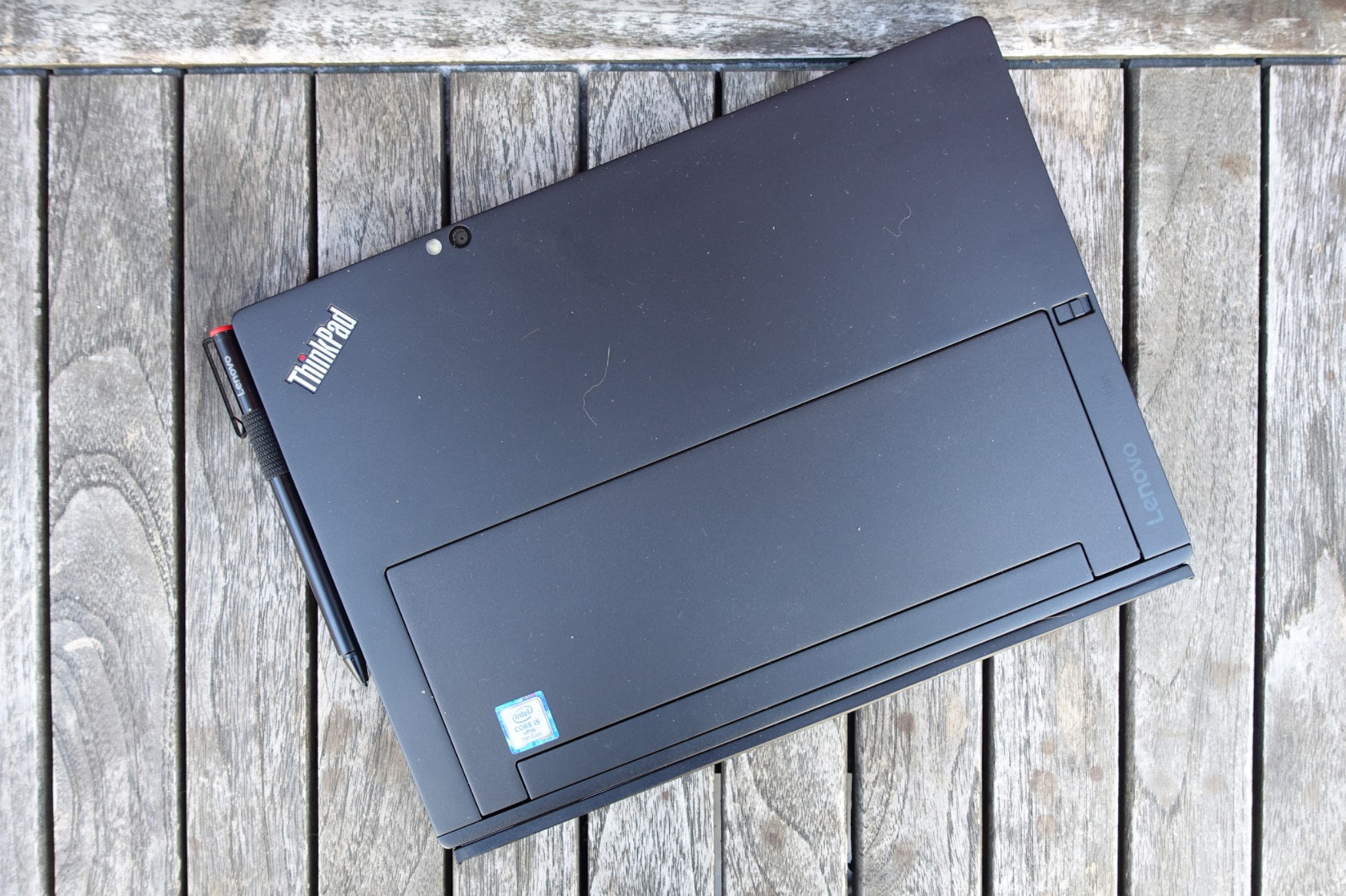
Unlike the majority of consumer detachables on the market, the ThinkPad X1 Tablet doesn’t come equipped with an IR camera next to its 2-megapixel webcam for passwordless Windows Hello logins. Instead, it relies on a fingerprint reader, mounted on the right edge of the tablet in landscape orientation (or on the bottom if the tablet is held in portrait mode), for Windows Hello authentication.
The placement of the fingerprint scanner makes it accessible to users whether the ThinkPad X1 Tablet is used as a slate without the keyboard attached or as a laptop with the keyboard folio engaged. Microsoft’s placement of the fingerprint reader on the Surface Pro 4’s Type Cover, for example, means that the reader is not accessible unless the keyboard is attached, but the Surface Pro 4 and this year’s Surface Pro both come with IR cameras on the tablet as an alternative to the fingerprint sensor.
Audio
Given its business focus, the ThinkPad X1 Tablet’s side-firing stereo speakers and dual-array microphones performed well for web and video conferencing. However, if you’re looking to use the tablet for multimedia consumption, the speakers are disappointing. Volume levels didn’t get loud enough for immersive video watching, and at high volumes, there was audio distortion.
If you’re using the ThinkPad X1 Tablet to consume videos or listen to music, you’ll likely want to plug in headphones or rely on Bluetooth speakers for better audio performance.
Specifications

Although the ThinkPad X1 Tablet is marketed with a Core i5 Intel Kaby Lake processor, it’s not the same chipset that’s found on the Surface Pro. Instead, like last year’s X1 Tablet, Lenovo opted to use Intel’s power efficient Y-series processor. Essentially, this means that this year’s X1 Tablet’s Core i5 chip is Intel’s rebadged Core m5 processor from last year.
The choice to go with a 4.5W Core i5-7Y57 processor means that the ThinkPad X1 Tablet will be more ideally suited for productivity tasks and consuming multimedia, rather than for more processor-heavy tasks. The tradeoff in performance means that the ThinkPad X1 Tablet should benefit from better battery life, emits less heat and doesn’t require a fan.
Our review unit is configured with a 1.2GHz Core i5-7Y57 processor—3.3GHz with TurboBoost—along with integrated Intel HD Graphics 615, 8GB LPDDR3 RAM and a 256GB NVMe M.2 SSD for storage. Given its business-focus, the ThinkPad X1 ships with a 64-bit Windows 10 Pro license from Microsoft. Enterprise features, such as TPM and vPro, are also supported.
The unit weighs 1.55 pounds without the keyboard, but goes up to 2.33 pounds with the keyboard attached. The tablet comes with a front-facing 2-megapixel webcam along with a rear-facing 8-megapixel camera. Business users can use the rear camera to scan documents and document their work in the field.
The keyboard and active pen are both included in the cost of the tablet. As reviewed, our configuration retails for $1,499. Optional upgrades include LTE, a faster Y-series Core i7 processor, 16GB RAM and 512GB SSD. The top-of-the-line model with WWAN costs $2,219.
Expansion and Upgrades
A major benefit in choosing an enterprise system is that it is serviceable. While the RAM is soldered onto the motherboard with the ThinkPad X1, you’ll still be able to remove the back cover to replace a depleted battery or upgrade the SSD to a faster drive or one that offers more storage capacity.
Because the non-WWAN model don’t come pre-wired with a nano SIM card slot, you’ll need to make your decision about LTE needs when you purchase your tablet— you won’t be able to simply drop in an LTE modem after your buy your system, unlike some of Lenovo’s other notebooks.
Performance

Despite the use of a low power Y-series processor (previously referred to as a Core M chip), performance of the ThinkPad X1 Tablet is smooth. The Core i5-7Y57 processor is able to drive most productivity tasks without any performance issues. And because the processor is power efficient, heat was never an issue despite the tablet lacking a fan. When streaming videos, the tablet got warm, but was never uncomfortable or overly hot to touch.
The smooth performance of the ThinkPad X1 Tablet this year is driven by two factors. First, Intel has made a lot of improvements to its Y-series processor line to squeeze out more performance. Second, the ThinkPad X1 benefits from a clean Windows 10 Signature Edition operating system with very minimal bloatware. It’s not saddled with preloaded apps that hog resources, like McAfee’s security suite.
I had no problems performing basic tasks, like working with Microsoft’s Office suite, running multiple browsers, streaming web videos and opening a number of Windows 10 applications. The tablet is capable of handling light Photoshop work, but if you expect to do heavy video editing or more advanced photo editing, you’ll likely be better off with a higher performance detachable, like Lenovo’s Miix 720, HP’s Spectre x2 or Microsoft’s Surface Pro—all these systems support better Intel integrated HD graphics and come with a more mainstream U-series Core i processor.
Performance of the Y-series Core i5—previously branded as Intel’s Core m5 processor—shows improvement. The integrated GPU scored 273 points using 3DMark’s Time Spy test.
Under PCMark 10’s test, the Y-series Core i5 scored 2,082 points. Under the old PCMark 8 test, the X1 Tablet generated a score of 2,273 points using the tool’s conventional work test. The tablet got a battery life score of four hours and 28 minutes using the same test.
Despite its lower power performance, these benchmarked results aren’t too far off from the more powerful U-series Core i5 processor on Lenovo’s Miix 720. The Miix 720, for example, has better graphics performance with a score of 318 points using the Time Spy test, but its score of 2,441 points under PCMark 8’s home test is within range of the X1 Tablet’s CPU performance.
Most users probably won’t notice—or won’t be bothered—by the performance differences between the lower Core i5 Y-series processor class. Gamers, those looking for mobile workstation-class performance or those with more advanced graphics needs will likely want to look at other solutions. For the majority of computing users—especially those who spend most of their time in the browser, working in Office or multitasking with less system intensive apps—will find the performance of the ThinkPad X1 Tablet to be more than satisfactory.
Battery Life
Battery life is a big area where the X1 Tablet could use some improvements. During my time with the tablet, I squeezed just under six hours of real world usage. If you invest in the Productivity Module, that expansion accessory comes with a built-in extended battery, which will give you more battery time.
The downside with the Productivity Module is that it will add heft to the tablet. The upside is that the barrel design of the Productivity Module makes it very comfortable to grip and hold the tablet. As a laptop, I like that it elevated the screen, making it more ergonomic to use. With the Productivity Module attached, my battery life nearly doubled, and I got close to eleven hours of screen-on usage.
Modularity

The Lenovo X1 Tablet supports modules for expansion. At present, Lenovo offers two separate modules—a $149 Productivity Module that adds an HDMI port, extended battery, a second USB Type-A port and support for Lenovo’s OneLink+ port for legacy docks as well as a $299 Presenter Module that comes with an HDMI port and a built-in pico projector capable of projecting a 60-inch image.
While the modules add to the cost of the tablet, they are useful for certain professionals, like salespeople looking to make an impromptu presentation, road warriors looking for extra battery life or users looking for extra ports for connectivity. The process of attaching a module to the tablet is simple, but attachment mechanism is a bit cumbersome. The modules attach to the bottom of the tablet, where the keyboard folio normally snaps onto the X1 Tablet. However, before you can add a module, you must remove a thin metal plate on the bottom of the tablet. The plate can be disengaged with a quick slider, but that’s another piece you must stow when you want to attach a module.
The good news is that the keyboard can be used even with the modules attached. Each module comes with two positions to attach the keyboard—one on the front, which allows the keyboard to attach as a cover and for use in laptop mode, and one on the rear, if you want to just stow the keyboard and use the package as a tablet without having to carry the keyboard separately. Additionally, because the modules add to the height of the tablet in laptop mode, the keyboard cover can be used in three different angles with the Productivity Module—a flat angle, a slightly elevated angle (like hooking the keyboard up to the front edge of the tablet without the module attached), and a higher angle for an even more elevated keyboard.
Another benefit with the Productivity Module is battery life—the built-in battery of the module essentially doubles the battery life of the tablet. Without the Productivity Module attached, I found battery life on the tablet to be somewhat anemic despite Lenovo’s decision to go with a low power Y-series chipset. With the Productivity Module, you’ll be able to use the X1 Tablet comfortably for well over a full work day without having to recharge.
Verdict
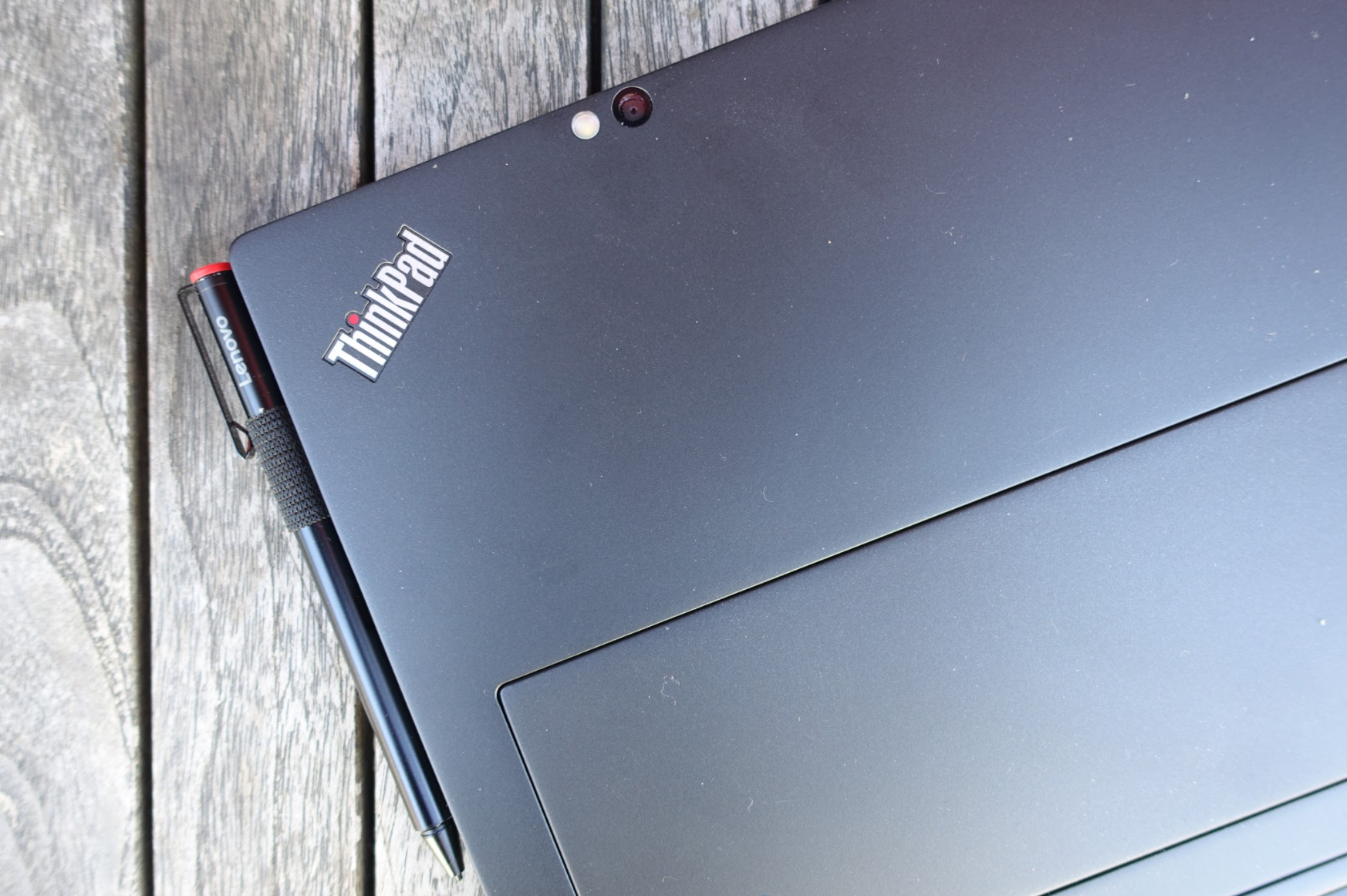
The ThinkPad X1 Tablet is a more rugged business alternative to Microsoft’s Surface Pro, boasting excellent construction, superb keyboard ergonomics and Lenovo’s own unique kickstand twist that makes the detachable more lapable when used as a laptop. This year, Lenovo upgraded the X1 Tablet’s processor to Intel’s latest Y-Series Kaby Lake chipset, which comes with better processing and graphics performance, and made some subtle design tweaks that improves on an already respectable build.
The keyboard on this tablet is still best-in-class, befitting of the X1 Tablet’s ThinkPad heritage, and the expandable design makes it a very versatile mobile PC. Along with the ability to change a depleted battery if it fails to hold a charge years down the road and the capability to upgrade the SSD, the modular design means that you can add business accessories—like a projector or extended battery—to the compact tablet design when you need to.
There are still some small improvements that Lenovo could implement for next year’s model—a switch to a more powerful U-series Core i processor would make this the business slate to beat. Like last year’s model, Thunderbolt 3 over USB Type-C support is still missing, and battery life could use some improvements. However, if you’re a traveling professional who live by a projector, the expandable module design on the X1 Tablet is currently peerless. Lenovo currently has no plans to introduce new modules, but we hope that changes as new modules could make this versatile slate even more powerful and useful to road warriors.